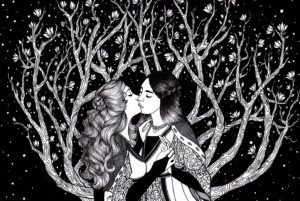Hattie Garlick at the TLS:
 Refashioning history to include its countless heroines is essential work, long overdue. But what of the future? Will these books, as the introduction to Herstory implores, truly encourage young girls to “take inspiration from these . . . amazing women and girls and shake things up!”? Perhaps. Last year, Science magazine published research investigating the age at which girls begin to think that they are less intellectually brilliant than boys. The study involved reading two stories to children between the ages of five and seven. One, they explained, was about a “really, really smart” person; the other, a “really, really nice” one. Afterwards, the children were asked which was about a girl, and which about a boy. At five, the boys were sure the “really, really smart” character was a boy, the girls equally adamant it was a girl. By six, however, something had changed. In the space of twelve months, the girls had become 20 per cent less likely to think that a clever character could share their gender. According to Dario Cvencek, a research scientist at the University of Washington, the results would be more depressing still had the hero of the book been a mathematician. Children absorb the gender prejudices on display in their environments and reading matter from the age of around five, he says – especially the idea that girls don’t do numbers. The stereotypes portrayed in their reading material become their own stereotypes and, worse still, the limits of their ambitions. The most powerful way to combat this, as the psychologist Nilanjana Dasgupta has found, is through providing successful female role models to small girls before the disease sets in, as a form of “stereotype inoculation”.
Refashioning history to include its countless heroines is essential work, long overdue. But what of the future? Will these books, as the introduction to Herstory implores, truly encourage young girls to “take inspiration from these . . . amazing women and girls and shake things up!”? Perhaps. Last year, Science magazine published research investigating the age at which girls begin to think that they are less intellectually brilliant than boys. The study involved reading two stories to children between the ages of five and seven. One, they explained, was about a “really, really smart” person; the other, a “really, really nice” one. Afterwards, the children were asked which was about a girl, and which about a boy. At five, the boys were sure the “really, really smart” character was a boy, the girls equally adamant it was a girl. By six, however, something had changed. In the space of twelve months, the girls had become 20 per cent less likely to think that a clever character could share their gender. According to Dario Cvencek, a research scientist at the University of Washington, the results would be more depressing still had the hero of the book been a mathematician. Children absorb the gender prejudices on display in their environments and reading matter from the age of around five, he says – especially the idea that girls don’t do numbers. The stereotypes portrayed in their reading material become their own stereotypes and, worse still, the limits of their ambitions. The most powerful way to combat this, as the psychologist Nilanjana Dasgupta has found, is through providing successful female role models to small girls before the disease sets in, as a form of “stereotype inoculation”.
more here.
